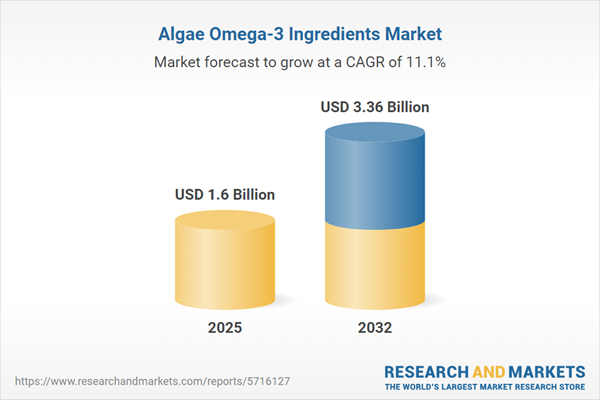Speak directly to the analyst to clarify any post sales queries you may have.
The algae omega-3 ingredients market is transforming as sustainability priorities and modernized supply chains drive industry adaptation. Senior executives are reevaluating sourcing, market approaches, and operational frameworks to reliably address shifting customer demands and meet evolving regulatory benchmarks.
Market Snapshot: Algae Omega-3 Ingredients Market Growth
In 2024, the algae omega-3 ingredients market is valued at USD 1.44 billion, projected to grow to USD 1.60 billion by 2025 and reach USD 3.36 billion by 2032. With an expected compound annual growth rate (CAGR) of 11.10%, this upward trajectory underlines persistent demand for plant-based nutrition and heightened sourcing efficiency. Industry operators are responding to increased calls for supply chain visibility, preparing for regulatory change and competitive realignment. Asia stands out as the primary catalyst for regional expansion, supported by the sector’s capability to address local customization and accelerate market readiness through agile strategies.
Scope & Segmentation: Algae Omega-3 Ingredients Market
- Applications: The market addresses a broad range of use cases, such as aquaculture, animal and pet nutrition, cosmetic ingredients for hair and skin, dietary supplements in both powder and capsule forms, bakery and dairy enhancements, infant nutrition, functional foods, and pharmaceutical needs across prescription and over-the-counter segments. Each serves distinct industry resilience goals and responds to contemporary user requirements.
- Source Varieties: Primary production utilizes microalgae strains including Crypthecodinium Cohnii, Nannochloropsis, and Schizochytrium. These offer regulatory adaptability and tailored ingredient profiles, ensuring alignment with global standards and manufacturing diversity.
- Form Factors: Key product types include oils, encapsulations, freeze-dried and spray-dried powders, and nanoemulsions. These formats are selected for application-optimized delivery, stability, and integration with high-performance product formulations spanning nutrition, personal care, and clinical sectors.
- Production Technologies: The industry employs heterotrophic fermentation—for batch, fed-batch, or continuous processing—as well as photoautotrophic systems utilizing open ponds and photobioreactors. This dual approach ensures flexible capacity scaling and reliable supply alignment with both specialty and volume requirements.
- Purity Levels: Ingredient offerings extend from standard to ultra-high purity grades. Each delivers full traceability to support adherence to strict food safety and medical standards.
- Distribution Channels: Distribution strategies include direct B2B relationships, broad partner networks, and digital platforms, adapting to customer procurement preferences and increasing accessibility across key markets.
- Regional Coverage: The Americas, EMEA, and Asia-Pacific remain core markets. Dynamic expansion in China, India, Japan, and Southeast Asia is underpinned by local compliance acumen and regionally aligned go-to-market strategies.
- Company Coverage: Leading companies in this space include Koninklijke DSM N.V., Corbion N.V., BASF SE, Veramaris GmbH, Qualitas Health, Polaris Renewable Biotech Co., Ltd., Beijing Gingko Group Co., Ltd., Algatech Ltd., Bioriginal Food & Science Ltd., and Cellana, Inc., each recognized for technological innovation and scalable operations.
Key Takeaways for Strategic Decision-Making
- Focusing on transparency throughout the supply chain builds partner confidence and enables companies to react quickly to regulatory developments while fortifying business relationships.
- Adopting modern cultivation and production solutions allows for agile adaptation to emerging policy and market trends, supporting innovation and operational stability.
- Developing novel ingredient formats such as nanoemulsions and encapsulated oils creates fresh avenues for engagement in health, wellness, and personal care markets.
- Integrating comprehensive traceability tools is central to sustaining compliance standards across diverse geographic areas and reinforcing client assurance.
- Applying detailed regional knowledge and market-specific tactics opens new growth avenues and aligns operations with shifting industry patterns.
- Expanding robust distributor networks, leveraging both physical and digital channels, increases market penetration and strengthens competitive positioning across all industry segments.
Tariff Impact: U.S. Trade Policy and Operational Adaptation
Recently implemented U.S. tariffs on algae omega-3 ingredients are prompting organizations to review sourcing networks and production structures. A deliberate emphasis on nearshoring and enhanced regional supplier collaboration helps manage supply continuity and supports long-term operational stability amid regulatory changes.
Methodology & Data Sources
This analysis combines findings from more than forty executive interviews, review of global patent filings, assessment of scientific publications, and corroborated industry data. By integrating these methods, the report provides a holistic and validated outlook on sector drivers and risk factors.
Why This Report Matters
- Delivers actionable, data-driven insights for executive decision-making in strategy and resource allocation.
- Prepares organizations to navigate evolving regulations, technological advancements, and regional complexities within a dynamic industry ecosystem.
- Supports informed decisions on investment, partnerships, and product innovation to strengthen market presence in targeted categories and geographies.
Conclusion
This report empowers leaders to confidently pursue innovation, compliance, and growth initiatives across the evolving algae omega-3 ingredients landscape.
Additional Product Information:
- Purchase of this report includes 1 year online access with quarterly updates.
- This report can be updated on request. Please contact our Customer Experience team using the Ask a Question widget on our website.
Table of Contents
3. Executive Summary
4. Market Overview
7. Cumulative Impact of Artificial Intelligence 2025
Companies Mentioned
The companies profiled in this Algae Omega-3 Ingredients market report include:- Koninklijke DSM N.V.
- Corbion N.V.
- BASF SE
- Veramaris GmbH
- Qualitas Health, Inc.
- Polaris Renewable Biotech Co., Ltd.
- Beijing Gingko Group Co., Ltd.
- Algatech Ltd.
- Bioriginal Food & Science Ltd.
- Cellana, Inc.
Table Information
| Report Attribute | Details |
|---|---|
| No. of Pages | 183 |
| Published | October 2025 |
| Forecast Period | 2025 - 2032 |
| Estimated Market Value ( USD | $ 1.6 Billion |
| Forecasted Market Value ( USD | $ 3.36 Billion |
| Compound Annual Growth Rate | 11.1% |
| Regions Covered | Global |
| No. of Companies Mentioned | 11 |









